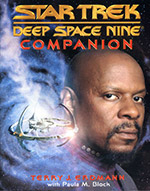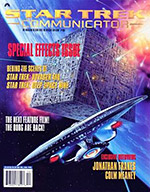In-Universe:
The U.S.S. Defiant fires it's extremely powerful pulse cannon phasers at a group of Jem'Hadar fighters.
Production:

Gary Hutzel was the Visual Effects Supervisor (and the Visual Effects Coordinator was Judy Elkins) and he needed something that would break apart. The team wanted the scene to say that Sisko is really turning it on, so we designed the shot to have the Defiant fly right through a Jem'Hadar ship. Hutzel chose a model that had originally been built for the second-season episode, "The Jem'Hadar." Then Tony Meininger cast a series of small sections from that ship's molds. In the motion-control studio, Hutzel aligned the sections to natch up with corresponding sections in the footage of the full model. He then photographed them individually, and when the Defiant "collides" with the Jem'Hadar vessel, those are the pieces that actually break away and fly off into space. But when you look at the final shot-Hutzel laughs-"you see a Jem'Hadar ship blowing up, because that's all your supposed to see."
- Source unknown -- DS9 Companion maybe?
 "It's prohibitively expensive for Deep Space Nine," Heutzel says of CGI. "Dan set out with Star Trek: Voyager to create a new look, but we have a show that is established. And nobody's going to accept a CGI Defiant that has that kind of texture to it, so we're forced to create really photo-realistic CGI elements that have to be consistent with the look of our show - and it's expensive. Plus, I prefer to photograph the ships, especially a beautiful ship like the Defiant, or the station."
"It's prohibitively expensive for Deep Space Nine," Heutzel says of CGI. "Dan set out with Star Trek: Voyager to create a new look, but we have a show that is established. And nobody's going to accept a CGI Defiant that has that kind of texture to it, so we're forced to create really photo-realistic CGI elements that have to be consistent with the look of our show - and it's expensive. Plus, I prefer to photograph the ships, especially a beautiful ship like the Defiant, or the station."
Probably the most traditionally impressive show in visual effects for ST: DS9 this year was "The Die is Cast." No CGI at all was used for the huge Gamma Quadrant battle between scores of the Dominion's Jem'Hadar ships and secret Cardassian and Romulan forces, all filmed at Image G, the off-lot studio where Trek's models and many other effects are flimed live on computerized, or "motion-controlled," rig.
"We started shooting motion-control on February 21, and we delivered on April 21," Hutzel recalls with a long sigh. "We had 20 days of motion-control shooting - a record for a one-hour show." An average shoot at Image G, he adds, is usually two days for an entire episode; five is "extraordinary" - and the climatic "money shot" of the battle when the Defiant blasts right through an oncoming Jem'Hadar ship took four days to shoot.
Gary Hutzel - Star Trek Communicator #105 (Page 57-58)




